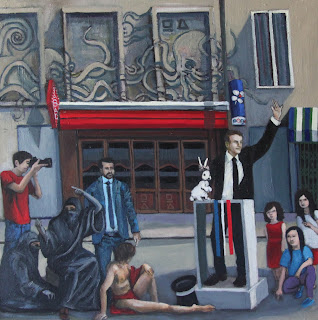When everything is anything and nothing and everything
Roy Forget, “Contingences (Le Lapin)”, Oil on linen, 70 x 70 cm, 2013-2018
The concept of the porosity of the “high” and the “low,” a fanciful idea full of pseudo-democratizing affectations, has been around for what seems like an eternity in internet time. So much so that it has become one of the foregone conclusions, à priori constructs of contemporary culture. Everywhere one goes, there are innumerable sound bites, discourses, and justifications citing the celebration of this very strange thing we call ‘Popular Culture.” In 2018, it is perhaps more honest to call it “Commercial” culture.
There are a number of issues with the idea of the porosity of the high and the low in culture as it metaphorically or otherwise pretends that the lower classes can rise to the upper classes, and that the upper classes welcome the energy of the lower classes. It presumes a flattening of the playing field, but is it really that innocent?
Of course, the underling presumption is that this culture that is sold to the masses at big discount prices is “of the People,” and therefore, the opposite of “snobbish” high culture, reserved for a projected idea of “snobs and intellectuals and better than though cultural puritans.” It is pure fantasy most of the time, and more often than not, just another excuse to sell more merchandise to the largest number of people, the lowest denominator.
In 2018, we are so far away from the moment when Gauguin and the Nabis painters went out to “remote” Brittany to observe the purity of the peasants who tilled the earth with authenticity (Gauguin never found it there and he did not find it either in Tahiti), that to preserve any belief in the prescient innocence of our contemporary culture of commerce and merchandising is make-believe.
In France, there is a certain cultural posturing where anything that is supposedly loved by the populace is given a sort of “pass” and assumed to be, having no other way to quantify it, “cool.” And so, wherever one goes, like the stony flat beaches of Le Havre, just a short train ride from Paris, by way of the Gare Saint Lazare, and therefore accessible to the masses of less well-to-do citizens of the Republic, one hears people of a certain well-to-do class say things like, “j’adore, c’est populaire !” This meaning, “it is so low, I do declare I love it!” Saying so presupposes two things. Number one, one is conscious that what one is seeing, hearing, experiencing, is very far from what one knows or would presume is considered “high.” Number two, as such, in order to not be a snob, one must declare forthright that one loves it.
What does one encounter on the boardwalk along the endless stony beach of Le Havre? Well, it is no longer the airy humidity of one of Eugène Boudin’s beach scenes. There are rows and rows of bars, restaurants and other sources of fast-food, all playing very loud electronic generated beats as background music, there is a small field for football (soccer), and there are endless cabins (painted wood shacks in American eyes), all blocking the view of the sea.
If one is of the sort who does not like fast-food, or the view of wood shacks, then it is actually quite hard to enjoy the beach of Le Havre. I guess it depends on what one is looking for when one heads out there, whether it is to repeat the exact experience of the loud music, fast-food and amusements of Paris, but “by the sea,” or perhaps one is looking for a change, something quite the opposite.
Let’s be real here, who produces this sort of culture? Is it the people, or is it some sort of business, selling cheap merchandise, throwaway gadgets and toys, unhealthy fast-food, blaring sincerely what one would call noise, all this justified by a sort of condescending “we are providing for the needs of the people.” As if the “people” are incapable of enjoying something quite the opposite. To frame the question a bit differently, is the Disney corporation the true purveyor of popular culture, is DC Comics, Marvel, all these billionaire enterprises, are they the true source of popular culture? If so, then we are in short saying that our culture is no better than some executive boardroom’s decision of what would sell at the most profitable price possible to the greatest number of people. Of course, the quick retort is “if they don’t want it, then they wouldn’t have come.” But where else can one go on minimum wage paychecks or barely adequate welfare subsidies?
We are paying a very high price for the continuation of this commercial culture. Climate change is not a lie, the oceans are filling up with our plastic trash, every Saturday morning at the park, the walkways are covered by shattered beer bottles from the desperate frenetic partying of the night before. Come to romantic Paris and drive outside of the city for five minutes into the projects to the north or the east or the south and experience the “beauty” of frenetic urbanization and population boom. To say that one loves all this is a perversion to excuse the spiteful mismanagement of human lives by those who felt that it is more important to reward the rich and let the poor, well, manage to survive. There definitely is a high and low, but it is in Capital. There are the rich and the poor and the ever more precarious middle class, and to pretend that the high is low and that the low is high is to pretend that the exploitation of people, of natural resources, of life, is just as well, just as good as anything else. It is not and we need to stop pretending it is so.



Comments
Post a Comment